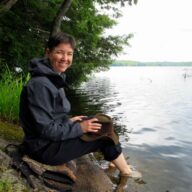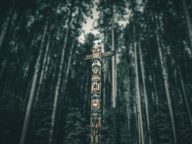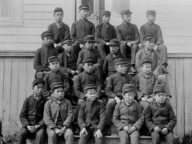Surprised in 3 places
The plastic chairs squeak as the feet shuffle in. The murmur of voices falls with the house lights. A projector buzzes. A white screen glows, the only “window” breaking up the plain walls and sound-proofed ceiling.
It’s a lecture hall, one that could be anywhere in the world—until the speaker begins:
J’aimerais commencer par reconnaître que l’Université Concordia est située en territoire autochtone, lequel n’a jamais été cédé. Je reconnais la nation Kanien’kehá: ka comme gardienne des terres et des eaux sur lesquelles nous nous réunissons aujourd’hui.
I would like to begin by acknowledging that Concordia University is located on unceded Indigenous lands. The Kanien’kehá:ka Nation is recognized as the custodians of the lands and waters on which we gather today.
What if land acknowledgements burst through the sameness of our spaces and made them places?
Elsewhere, the fans are ready—on their feet—swept up in enthusiasm for their team. They can recount the victories and tragedies, the heroes and rivals. They are part of this team’s story, which includes standing for the national anthem.
But then an announcement rings through the speakers:
Bell MTS Place is located on Treaty One lands, the original territories of the Anishinaabe, Cree, Oji-Cree, Dakota, Lakota, Dene peoples, and the homeland of the Métis Nation.
What if land acknowledgements disrupted divisions, calling people beyond their small loyalties, into a bigger story?
In another room, on another tab, there’s another distraction. Click, click, click. Some sites are slick, others load too slowly. Some have too many advertisements, some are confusing. Flipping from one page to the next, time slips easily.
The internet is its own disembodied world, both two feet and a million miles away—except sometimes a statement:
Coracle Marketing operates on the traditional, ancestral and unceded territory of the kʷikʷəƛ̓əm (Kwikwetlem), sq̓əc̓iy̓aɁɬ təməxʷ (Katzie), Semiahmoo, Kwantlen, S’ólh Téméxw (Stó:lō), and other Coast Salish Peoples.
What if land acknowledgements “placed” the people and products of the internet, in a way that inspires empathy?
Re-awaken wonder
In our globalized world—where building styles and materials are standardized, and franchises are purposefully generic—land acknowledgements remind me that I’m in a specific place. They not only acknowledge the historic and continued presence of Indigenous peoples, but the land itself.
The Christian story of creation asserts that God’s world is a good masterpiece. Creative geographic differences don’t need to be painted over with sameness. Though often hidden under buildings and asphalt, when the physical land is acknowledged, I have the opportunity to be re-awakened to the wonder of being in a specific place, in all it’s unique goodness.
Remember what’s shared
In our divided world—where people find themselves in political camps and narratives of “us” and “them”—land acknowledgements remind me that I’m in a broader story of humanity.
My Christian faith teaches me that the stories of humanity are important. It’s a story which stretches all the way back to creation and all the way forward to when God will restore all things. When I’m caught up in a particular echo chamber, it’s much too easy to only see parts of history, one version of current events, or a single narrative of tomorrow.
True, a public land acknowledgement cannot say all there is to say about the past, present, or future. But it invites all people into a story in which they have a part to play, regardless of what jersey they wear.
Reconnect with reality
In our digital world—where human interactions can be reduced to avatars—land acknowledgements remind me that there are specific people in specific places behind the content and products that I’m viewing.
The Christian story of redemption centres on God coming to live in a specific context. You can still go to the places where Jesus, God-in-the-flesh, was born, grew, taught, healed, died, and returned to life. Those physical locations shaped who he encountered, how he taught, and where he prayed. When I’m on my digital devices, I tend to forget that my day is also shaped by my neighbours and my morning walk, the weather and the view out my window.
Coming across a land acknowledgement online is a chance to reimagine what I see: the digital is not disconnected from real people in real places.
There’s more to land acknowledgements
Of course land acknowledgements are more than a nice reminder of being in a specific place, with specific people, because of a specific history. And they certainly aren’t just for me, a settler with roots in Germany, Switzerland, and the British Isles.
They aren’t designed to be comfortable, but to highlight tension: settlers aren’t entitled to the land, even if they are legally allowed to live on it through treaties. But perhaps understanding land acknowledgements from a different angle will help people like me lean into the discomfort: What if they weren’t about politics, but about being a healthy human, grounded in God’s good—and physical, relational, and storied—world?
I’m writing this from land covered by the Dish with One Spoon wampum belt, a sacred covenant between the Anishinaabe and Haudenosaunee nations, the original keepers of this beautiful, particular place; I thank God for them and I’ve been asking him to shape me into someone who’s a good friend to these peoples.
Where are you reading this from?
Editor’s Note: Wondering about the history of the land you’re on? Check out native-land.ca for a map.
"*" indicates required fields
Share this!
About the Author





